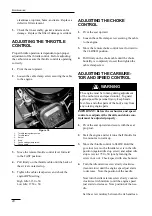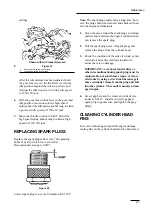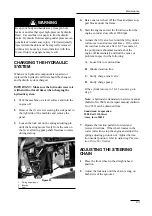
CHARGING THE HYDRAULIC
SYSTEM
Whenever a hydraulic component is repaired or
replaced the hydraulic oil filter should be changed
and hydraulic system charged.
IMPORTANT: Make sure the hydraulic reservoir
is filled with oil at all times when charging the
hydraulic system.
1.
Park the machine on a level surface and turn the
engine off.
2.
Remove the (3) screws securing the side panel to
the right side of the machine and remove the
panel.
3.
Loosen the lock nut on the spring adjusting pin
until the bearing moves freely from the cam on
the lever, allowing pump shaft freedom to rotate
during start-up.
4.
Raise one rear wheel off the floor and place sup-
port blocks under the frame.
5.
Start the engine and set the throttle to allow the
engine to run at slow idle at 1800 rpm.
6.
Actuate the lift valve lever until the lift cylinder
rod moves in and out several times. If the cylin-
der rod does not move after 10–15 seconds, or
the pump emits abnormal sounds, shut the
engine off immediately and find the cause or
problem. Inspect for the following:
A. Loose filter or suction lines.
B. Blocked suction line.
C. Faulty charge relief valve.
D. Faulty charge pump.
If the cylinder moves in 10–15 seconds, go to
step 7.
Note: A hydrostatic transmission service manual
(bulletin No. 9646) and a repair manual (bulletin
No. 9659) can be obtained from:
Sundstrand Corporation
2800 East 13th Street
Ames, Iowa 50010
7.
Operate the traction pedal in forward and
reverse directions. If the wheel rotates in the
correct direction, stop the engine and adjust the
spring adjusting pin lock nut. Adjust the trac-
tion neutral position: refer to Adjusting The trac-
tion Drive For Neutral.
ADJUSTING THE STEERING
CHAIN
1.
Place the front wheel in the straight-ahead
position.
2.
Adjust the locknuts until the chain is snug on
both sides of the sprocket.
23
Maintenance
Figure 23
1.
Spring adjusting pin
2.
Bearing
3.
Cam
Keep your body and hands away from pin hole
leaks or nozzles that eject high-pressure hydraulic
fluid. Use cardboard or paper to find hydraulic
leaks. Hydraulic fluid escaping under pressure can
penetrate skin and cause injury. Fluid accidentally
injected into the skin must be surgically removed
within a few hours by a doctor familiar with this
form of injury or gangrene may result.
WARNING
➀
➁
➂






































